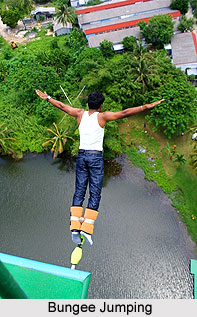 Bungee jumping in India is an activity of jumping from high structure or altitude while connected to a huge elastic cord. This particular structure is generally fixed on crane, building or bridge but sometimes it is also possible to jump from moveable objects like helicopters, balloons and many more. In this kind of sports - Bungee jumping, an elastic cord is attached with bungee jumper`s ankles and other end is also tied to the jumping off node. As soon as the jumper jumps, the cord stretches and the jumper also flies upward again as the cord recoils and also continues to oscillate down and up until all the energy is dissipated.
Bungee jumping in India is an activity of jumping from high structure or altitude while connected to a huge elastic cord. This particular structure is generally fixed on crane, building or bridge but sometimes it is also possible to jump from moveable objects like helicopters, balloons and many more. In this kind of sports - Bungee jumping, an elastic cord is attached with bungee jumper`s ankles and other end is also tied to the jumping off node. As soon as the jumper jumps, the cord stretches and the jumper also flies upward again as the cord recoils and also continues to oscillate down and up until all the energy is dissipated.
It is a general characteristic of human beings to push oneself. There is actually nothing more daring than challenging fate and surviving to tell the entire episode. This form of adventure sport attracts both seekers of new experience and those terrified of the work that would like to overcome their fears. According to the experts, the Bungee jumping as a sport is one of the safest sports and there is less chance for an individual to get hurt, and chances of getting hurt during a bike ride is much higher.
This sport has various methods of jumping. Among them the body leg and arm harness, back dive, railing jump, cage dive, elevator are essential tools. Swallow dive is one of the best in the above list. In the swallow dive, the jumper actually makes the dive with arms entirely stretched. Here the jumper jumps like a bird.
At the outset it may seem that falling from a height of 120 to 700 feet and bunging up and down is only for those who have little love left for their life. But, in reality, there is only little risk involved in this game, as most of the institutions that hold such events maintain high quality of safety and professionalism. If one can overcome fear, he would he perfectly okay after all.
There are however, considerable amount of debate regarding the origin of the game. There are some who say that it started in Pacific, with people of Vanatu, who throw themselves down from the towers with their ankle ties with vines. According to the myths and legends, the game got its first ever jumper around 1,500 years ago. This actually happened when tribal ran away from her angry husband who attempted to kill her. But when she saw her husband gaining in speed, she climbed a tree perched herself on the top. But her husband followed her even there. As last resort, she tied her legs with few vines and as a result jumped on, thereby giving birth to this new form of adventure sport.
Bungee jumping was commercialized in the late eighties, and within the few years, it became quite popular in North America and Europe. Bungee jumping came to India in the 1990s, and presently most of the metro cities in India have this sport.
Equipments used in Bungee Jumping
Cords
Most of the cords for bungee jumping are made from natural rubber. The commonly used cord for bungee jumping like Euro and Mil Spec cords stretch 2 to 4 times the original length and the jumper feels 2.5 to 3.5 G`s. It is thus crucial to note that commonly mountaineering cords are also used for bungee jumping, but they should be stronger as the stress on the cord is always more while a person is participating in a bungee jumping.
Harness
For a bungee jumper, he always uses two types of harness. One is of course leg harness that is attached with cord and other is body harness to give the backdrop.
Big Equipment
A big equipment is one from which a bungee jumper takes his jump. It can be a mobile crane, a bungee tower, a river bridge, bungee platform of a building, etc.
Other Equipment of Bungee Jumper
* Jump Deck
* Rigging System
* Additional Requirements for Elevating Jump Decks
* Portable Hoisting Device
* Harnessing Procedures and Specifications
* Rigging Equipment and Hardware
* Carabiners
* Slings/Webbing
* Ropes
* Pulleys/Shackles
* Ascenders and Descenders
* Scales
* Retrieval Vessel
* Equipment Inspection, Testing, Maintenance and Replacement
* Bungee Cords
* Hardware
* Ropes, Cables and Webbing/Slings




